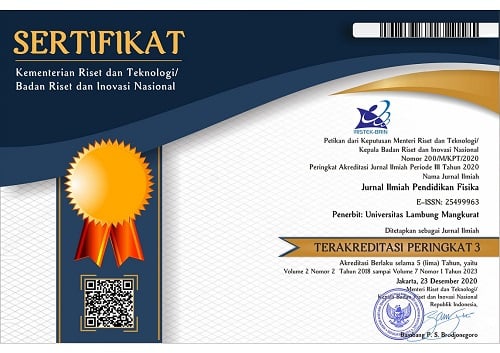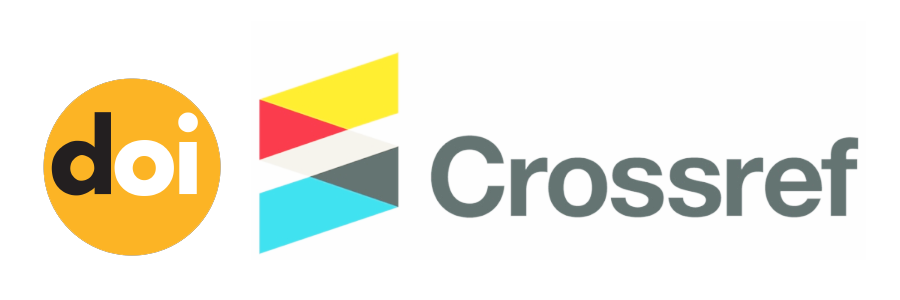Implementation of Conceptual Change Model - Computational Thinking (CCM-CT) to Increase Students’ Conceptual Understanding in Pascal’s Law
Abstract
This research aimed to implement the Conceptual Change Model - Computational Thinking (CCM-CT) in enhancing students’ conceptual understanding of Pascal’s Law. This research used a quasi-experimental design with a pretest-posttest control-group design. The population for this research comprised all second-semester grade XI MIPA students in a public high school in Bandung City. The sampling method used was purposive sampling, specifically selecting students who had not previously studied Pascal's Law material. The sample included two classes: the experimental class, which received treatment through CCM-CT learning, and the control class, which underwent treatment using CCM learning. The experimental class consisted of 8 male students and 28 female students, while the control class consisted of 9 male students and 27 female students aged 15-17 years. The data collection technique for students’ conceptual understanding used a Four-tier test instrument on Pascal’s Law. The data analysis technique used the N-Gain test to assess the enhancement of students' conceptual understanding through activities to alter their conceptions during the learning process. The results revealed a distinction in conceptual understanding between students who utilized CCM-CT learning and those who employed CCM learning. The N-Gain pre-test and post-test values in the experimental class, which implemented CCM-CT learning, were 0.71, interpreted as "high," while in the control class applying CCM learning, the values were 0.62, interpreted as "enough." As a result, implementing CCM-CT proved to be an alternative teachers could utilize to enhance students' conceptual understanding. This was supported by the research findings, which demonstrated a higher level of concept understanding among students who underwent CCM-CT learning compared to those who underwent CCM learning.
Keywords
Full Text:
PDFReferences
Adriana Sari, N. P. E., Santyasa, I. W., & Gunadi, I. G. A. (2021). The effect of conceptual change models on students’ conceptual understanding in learning physics. Jurnal Pendidikan Fisika Indonesia, 17(2), 94–105. https://doi.org/10.15294/jpfi.v17i2.27585
Aripiani, S. K., Samsudin, A., Kaniawati, I., Novia, H., Aminudin, A. H., Sutrisno, A. D., & Coştu, B. (2023). Diagnostic instruments of four-tier test work and energy (FORTUNE) to identify the level of students’ conceptions. Tadris: Jurnal Keguruan Dan Ilmu Tarbiyah, 8(1), 19–32. https://doi.org/10.24042/tadris.v8i1.13524
Armagan, F. O., Keskin, M. O., & Akin, B. S. (2010). Effectiveness of conceptual change texts: A Meta analysis. Procedia - Social and Behavioral Sciences, 9, 1574–1579. https://doi.org/10.1016/j.sbspro.2010.12.367
Chen, B., Wei, L., & Li, H. (2016). Teaching complicated conceptual knowledge with simulation videos in foundational electrical engineering courses. Journal of Technology and Science Education, 6(3), 148–165. https://doi.org/10.3926/jotse.174
Chen, Y. T., & Wang, J. H. (2016). Analyzing with posner’s conceptual change model and toulmin’s model of argumentative demonstration in senior high school students’ mathematic learning. International Journal of Information and Education Technology, 6(6), 457–464. https://doi.org/10.7763/ijiet.2016.v6.732
Creswell, J. W. (2014). Research design qualitative, and mixed methods approaches 4th ed. SAGE Publications Inc.
Falloon, G. (2019). Using simulations to teach young students science concepts: An Experiential Learning theoretical analysis. Computers and Education, 135(March), 138–159. https://doi.org/10.1016/j.compedu.2019.03.001
Fratiwi, N. J., Kaniawati, I., Suhendi, E., Suyana, I., & Samsudin, A. (2017). The transformation of two-tier test into four-tier test on Newton’s laws concepts. AIP Conference Proceedings, 1848. https://doi.org/10.1063/1.4983967
Gopalan, M., Rosinger, K., & Ahn, J. Bin. (2020). Use of quasi-experimental research designs in education research: growth, promise, and challenges. Review of Research in Education, 44(1), 218–243. https://doi.org/10.3102/0091732X20903302
Gudmundsson, J. T. (2020). Physics and technology of magnetron sputtering discharges. Plasma Sources Science and Technology, 29(11). https://doi.org/10.1088/1361-6595/abb7bd
Hake, R. R. (1998). Interactive-engagement versus traditional methods: A six-thousand-student survey of mechanics test data for introductory physics courses. American Journal of Physics, 66(1), 64–74. https://doi.org/10.1119/1.18809
Hermita, N., Suhandi, A., Syaodih, E., & Samsudin, A. (2017). Level conceptual change mahasiswa calon guru sd terkait konsep benda netral sebagai efek implementasi vmmscctext. WaPFi (Wahana Pendidikan Fisika), 2(2), 71.
https://doi.org/10.17509/wapfi.v2i2.8270
Ikbal, Muh. S., Kamsinah, K., Dani, A. U., & S, N. (2021). The influence of the cooperative script model using the gasing method assisted by couple card media on concept understanding. Jurnal Ilmiah Pendidikan Fisika, 5(3), 424. https://doi.org/10.20527/jipf.v5i3.3927
Ismail, I. I., Samsudin, A., Suhendi, E., & Kaniawati, I. (2015). Diagnostik miskonsepsi melalui listrik dinamis four tier test. Prosiding Simposium Nasional Inovasi Dan Pembelajaran Sains, 2015(June 2015), 381.
Juniartini, N. W., Sudiatmika, A. A. I. A. R., & Sujanem, R. (2017). Pengaruh model pembelajaran perubahan konseptual berbantuan simulasi PhET untuk meningkatkan pemahaman konsep fisika siswa. Jurnal Pendidikan Fisika Undiksha, 7(2), 109–119.
Kong, S.-C., Abelson, H., & Kwok, W.-Y. (2022). Introduction to computational thinking education in k–12. In Computational Thinking Education in K–12. Springer Nature Singapore Pte Ltd. https://doi.org/10.7551/mitpress/13375.003.0002
Krathwohl, D. R., & Anderson, L. W. (2010). Merlin C. Wittrock and the revision of bloom’s taxonomy. Educational Psychologist, 45(1), 64–65. https://doi.org/10.1080/00461520903433562
Kurniawan, W., Darmaji, D., Astalini, A., Kurniawan, D. A., Hidayat, M., Kurniawan, N., & Farida, L. Z. N. (2019). Multimedia physics practicum reflective material based on problem solving for science process skills. International Journal of Evaluation and Research in Education, 8(4), 590–595. https://doi.org/10.11591/ijere.v8i4.20258
Leuchter, M., Saalbach, H., Studhalter, U., & Tettenborn, A. (2020). Teaching for conceptual change in preschool science: relations among teachers’ professional beliefs, knowledge, and instructional practice. International Journal of Science Education, 42(12), 1941–1967. https://doi.org/10.1080/09500693.2020.1805137
Makhrus, Muh., & Busyairi, A. (2022). Reducing misconception of force concepts through learning conceptual change model with cognitive conflict approach. Jurnal Pendidikan Fisika Dan Teknologi, 8(2), 184–192. https://doi.org/10.29303/jpft.v8i2.4332
Malik, A., Setiawan, A., Suhandi, A., Permanasari, A., Samsudin, A., Safitri, D., Lisdiani, S. A. S., Sapriadil, S., & Hermita, N. (2018). Using hot lab to increase pre-service physics teacher’s critical thinking skills related to the topic of RLC circuit. Journal of Physics: Conference Series, 1013(1). https://doi.org/10.1088/1742-6596/1013/1/012023
Meşe, E., & Sevilen, Ç. (2021). Factors influencing EFL students’ motivation in online learning: A qualitative case study. Journal of Educational Technology & Online Learning, 4(1), 12.
Ozkan, G., & Selcuk, G. S. (2016). Facilitating conceptual change in students’ understanding of concepts related to pressure. European Journal of Physics. https://doi.org/10.1088/0143-0807/37/5/055702
Putri, A. H., Samsudin, A., & Suhandi, A. (2022). Exhaustive studies before covid-19 pandemic attack of students’ conceptual change in science education: a literature review. Journal of Turkish Science Education, 19(3), 808–829. https://doi.org/10.36681/tused.2022.151
Ramankulov, S., Dosymov, Y., Turmambekov, T., Azizkhanov, D., Kurbanbekov, S., & Bekbayev, S. (2020). Integration of case study and digital technologies in physics teaching through the medium of a foreign language. International Journal of Emerging Technologies in Learning, 15(4), 142–157. https://doi.org/10.3991/ijet.v15i04.11699
Reski, A., Yuliatun, T., Hasanah, N., & Sari, D. K. (2023). Physics teachers’ perceptions of senior high schools in merauke on self-regulation of digital instructional materials. Jurnal Ilmiah Pendidikan Fisika, 7(1), 51. https://doi.org/10.20527/jipf.v7i1.6078
Rogers, M. M. (2021). Teaching-to-learn: its effects on conceptual knowledge learning in university students. International Journal of Innovative Teaching and Learning in Higher Education, 2(1), 1–14. https://doi.org/10.4018/ijitlhe.289863
Samsudin, A. (2023). Conceptual change based on virtual media (CC-VM) versus POE strategy: analysis of mental model improvement and changes on light wave concepts. International Journal of Technology in Education and Science, 7(2), 230–252.
https://doi.org/10.46328/ijtes.449
Samsudin, A., Azura, Kaniawati, I., Suhandi, A., Fratiwi, N. J., Supriyatman, Wibowo, F. C., Malik, A., & Costu, B. (2019). Unveiling students’ misconceptions through computer simulation-based PDEODE learning strategy on dynamic electricity. Journal of Physics: Conference Series, 1280(5). https://doi.org/10.1088/1742-6596/1280/5/052050
Samsudin, A., Fauzi, D. M., Suhandi, A., Linuwih, S., Masrifah, M., & Coştu, B. (2022). Can sound waves in computer simulation lower students’ misconceptions? Analysis of reduction and change. World Journal on Educational Technology: Current Issues, 14(5), 1398–1414. https://doi.org/10.18844/wjet.v14i5.7864
Samsudin, A., Suhandi, A., Rusdiana, D., Kaniawati, I., & Coştu, B. (2016). Investigating the effectiveness of an active learning based-interactive conceptual instruction (ALBICI) on electric field concept. Asia-Pacific Forum on Science Learning and Teaching, 17(1), 1–41.
Sari, M. W., & Nasrudin, H. (2015). Implementation of conceptual change learningmodel to reduce the student’s misconceptions on chemical bonding in x class sma negeri 4 sidoarjo. UNESA Journal of Chemical Education, 4(2), 315–324.
Scher, L., Kisker, E., & Dynarski, M. (2015). Designing and conducting strong quasi-experiments in education. In Decision Information Resources, Inc (Issue November).
Suhandi, A., Surtiana, Y., Husnah, I., Setiawan, W., Siahaan, P., Samsudin, A., & Costu, B. (2020). Fostering high school students’ misconception about boiling concept using conceptual change laboratory (cCLAb) activity. Universal Journal of Educational Research, 8(6), 2211–2217. https://doi.org/10.13189/ujer.2020.080603
Suhardiman, S., Damayanti, A., & Syamsudduha, S. (2022). Pengembangan LKPD konsep fluida statis berbasis problem solving polya peserta didik kelas xi ipa sman 2 bulukumba. Jurnal Ilmiah Pendidikan Fisika, 6(3), 610. https://doi.org/10.20527/jipf.v6i3.6220
Suherly, T., Azizahwati, A., & Rahmad, M. (2023). Kemampuan pemahaman konsep awal siswa dalam pembelajaran fisika : analisis tingkat pemahaman pada materi fluida Dinamis. Jurnal Paedagogy, 10(2), 494. https://doi.org/10.33394/jp.v10i2.7239
Vosniadou, S., Lawson, M. J., Wyra, M., Van Deur, P., Jeffries, D., & I Gusti Ngurah, D. (2020). Pre-service teachers’ beliefs about learning and teaching and about the self-regulation of learning: A conceptual change perspective. International Journal of Educational Research, 99(October 2019). https://doi.org/10.1016/j.ijer.2019.101495
Yudatika, S., & Jauhariyah, M. N. R. (2021). Meta-Analysis of inquiry learning models in physics learning. Jurnal Ilmiah Pendidikan Fisika, 5(3), 437–447. https://doi.org/https://doi.org/10.20527/jipf.v5i3.3993
Zuhdi, M., & Makhrus, M. (2020). Peningkatan pemahaman konsep fisika dasar melalui konflik kognitif dengan pertanyaan tak terduga. Jurnal Pendidikan Fisika Dan Teknologi, 6(2), 264–269. https://doi.org/10.29303/jpft.v6i2.2121
DOI: https://doi.org/10.20527/jipf.v8i1.11479
Refbacks
- There are currently no refbacks.
Indexed by: Jurnal Ilmiah Pendidikan Fisika is licensed under a creative commons attribution-share alike 4.0 international license
Statistics Counter |

















